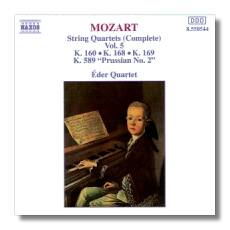
The Internet's Premier Classical Music Source
Related Links
- Mozart Reviews
- Latest Reviews
- More Reviews
-
By Composer
-
Collections
DVD & Blu-ray
Books
Concert Reviews
Articles/Interviews
Software
Audio
Search Amazon
Recommended Links
Site News
 CD Review
CD Review
Wolfgang Mozart

String Quartets, Volume 5
- String Quartet #7 in E Flat Major K. 160 (1773)
- String Quartet #8 "Haydn" #1 in F Major K. 168 (1773)
- String Quartet #9 "Haydn" #2 in A Major K. 169 (1773)
- String Quartet #22 "Prussian" #2 in B Flat Major K. 589 (1790)
Éder Quartet
Naxos 8.550544 1993 DDD 67:10
The "classical" era, an era that lent its name to all the serious music of western culture, lasted only a few decades. Born just before Haydn's output, it didn't survive him by long. It was parochial, too, drawing much of its vitality from the Viennese musical style. Yet, in spite of its limitations, it gave form and substance of universal musical utterances by some of the greatest composers of all time.
The era itself is, then, something of a paradox; and many others eddy from the source. Haydn, for example, is often conceived as a simple-minded but kindly "papa" who filled the forms he invented with tinkly, insubstantial music. Mozart, according to this view, is his spiritual progeny, occupying his brief lifetime with the composition of uncomplicatedly elegant music worthy only of a child-prodigy. These, so it would go, are the jailers from whom Beethoven rescued music. That this is nonsense is immediately apparent to anyone who takes the trouble to listen to a late Haydn Mass or a Mozart chamber work.
The Quartet, K. 589 is one of those compositions that reveal the depth and complexity of Mozart's musical imagination. By the time Mozart reached K. 589, the quartet itself had developed from the solo violin and accompaniment texture of Haydn's early works into a more balanced ensemble. Mozart's penchant for counterpoint doubtless helped equalize the voices – and pack the musical ideas tighter, setting music on the course that would eventually lead to the pregnant expressionism of Anton Webern. The Menuetto of the quartet, for example, is wound at least as tight as any of Beethoven's quartets, Op. 18, and is as intensely expressive. Mozart's increasingly condensed expression can be traced through the three earlier quartets performed on this disc. The first, K. 160, is cast in the three movements (fast-slow-fast) of an Italian sinfonia and is the most straightforward in its melodic style. The Quartets, K. 169 and 168, are significantly more developed harmonically and melodically, with polyphonic episodes prefiguring the later quartets dedicated to Haydn.
The music, then, is both profoundly serious and profoundly interesting. Here's proof, if proof were needed, that Beethoven was less an iconoclast than an inevitability. He didn't set music free; he caught handfuls of it as it went whizzing by, hurled by Haydn and Mozart. If the performances by the Éder Quartet aren't models of refinement, they aren't coarse and gritty, either. You might object to an occasional stylistic gaff. Scooping is no more tolerable in a string player than in a singer.
And you might object to the cathedral-like reverberation of the Unitarian Church in Budapest, where these recordings were made. It smothers the quartet in unwelcome resonances, and makes the cello boom like a cannon.
Still, the group plays with undeniable energy, and these works have a power of their own that refuses to be dampened. Overall, then, a worthwhile addition to Naxos' impressive catalog of chamber music, and a creditable fifth volume in the Éder Quartet's complete Mozart series. Highly recommended, especially at budget price.
Copyright © 1996, Robert Maxham


















